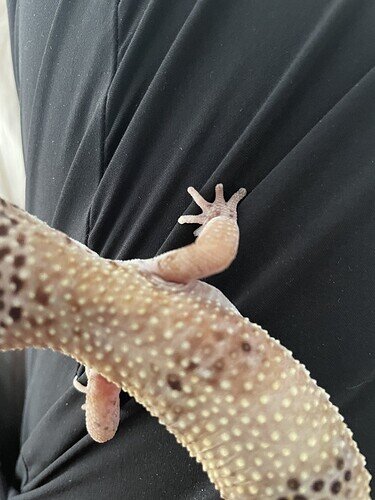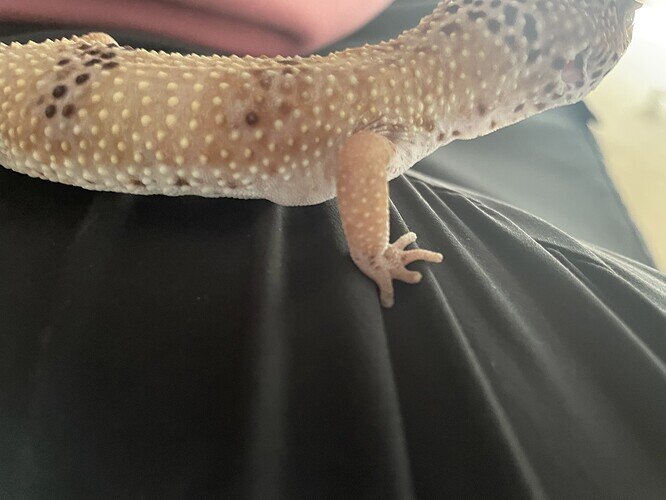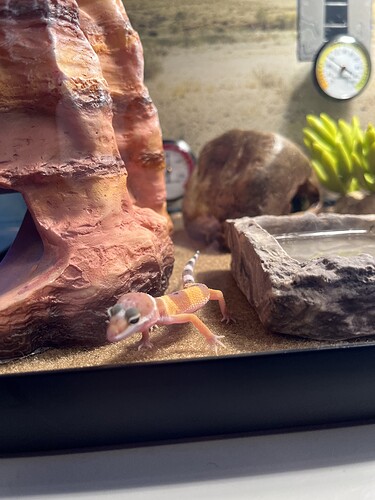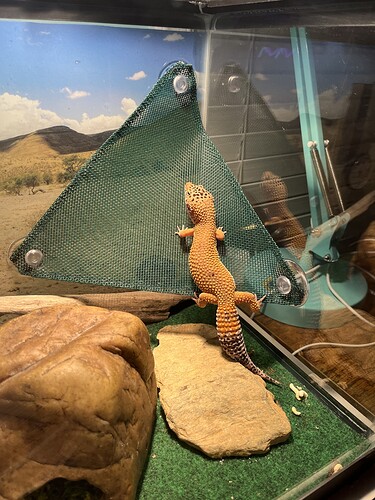Welcome to the forum! Feel free to make an introduction post in the ‘Introductions’ section if you have the time, it’s always cool to meet new fellow herpers. 
Armpit ‘bubbles’ are actually a fairly common issue in leopard geckos, and there’s no need to panic. They are not full of air, but rather fat, fluid from the body, and deposits of minerals.
I am not aware of anyone writing in an academic journal regarding the cause of the armpit bubbles. However, among hobbyists, they are generally thought to result from one or more of three possible factors:
- Obesity
- Oversupplementation (generally from Calcium with D3)
- Genetic factors
Because your gecko is 6+ years old and has not had them previously, genetic factors are less likely to be the cause. The next thing to rule out would be obesity. Is he overweight or has he recently gained weight? If not, then you more or less have to assume that oversupplementation is most likely.
In my experience, oversupplementation is most common in leos that are older (like ~10+ years) and/or male. Geckos that are no longer growing, and that do not form or produce eggs (males/older females) have a reduced need for calcium. Excess D3 forces calcium absorption whether the gecko needs it or not.
It is very possible and actually fairly common to give overdoses of calcium/D3 when trying to get the right balance when it comes to dusting and gutloading prey. It’s important to consider a bunch of factors that come into play when figuring out supplementation for every leo individually, so any simple/ one-size-fits-all schedule (e.g. ‘only feed __ and __, use gutloading formula xyz for _ hours before feeding, then dust every _ days with _’) is generally not sufficient to get things just right. For example, supplementation levels for breeding females during the breeding season should be much higher than for elderly males.
Factors to consider:
- sex
- reproductive status (some unbred females will lay duds & thus still need higher calcium levels)
- age
- what kind of prey items being fed
- how often are feedings
- how much being fed/dusted with per feeding
- what are you dusting with (Ca only, Ca w/D3, Ca + multivitamin, multivitamin w/out Ca, etc.)
-
what are you gutloading with prior to feeding out your prey items?
What I suggest in the case of your little man is to try slightly reducing the level of calcium in his diet (not overall nutrients, just calcium & D3) and observing for any change. This could be accomplished a number of ways, and the best method will vary depending on your feeding & supplementation practices.
To reduce calcium in the diet (always be gradual!):
- If prey items contain sufficient D3 in their gut, stop dusting with calcium with D3. Instead, use Ca without D3, and make sure to dust every few feedings with a vitamin supplement that does not contain calcium, but does have some d3
- I personally wouldn’t use any D3 in supplementation for a leo that has UVB lighting
- If you gutload with either Mazuri gut-loading formula or Repashy ‘Superload’ (my 2 fave brands), then you could start including insect maintenance food. So, not more if the high-Ca formula, rather swapping in some of a food made for prey bugs to grow & live prior to needing to be gutloaded). Prey insects cannot survive/thrive when fed high/Ca gutloading foods long term, so the ‘maintenance diet’ is what is fed to the insects prior to needing to be gutloaded.
- You could also switch in some non-high-Ca veggies for your prey during gutloading prior to being fed. When selecting veggies to feed, their Ca:P ratios can be very different, so do your research.
- Simply dust prey less frequently.
If you try those methods and there’s no change with the ‘bubbles,’ honestly it’s probably fine. If the bubbles start growing or looking unhealthy (e.g. a color change), then it’s time for a vet visit with a reptile specialist. Bloodwork will help determine exactly how high your little one’s blood calcium levels are or are not, and you could make adjustments based on the super accurate info. If you are extremely concerned, you could get radiographs taken, but in almost all cases it appears that the armpit bubbles don’t cause problems.
Example:
I currently have 2 geckos with big armpit bubbles of my own.
- One of them is a 20 year old female, Veruca, that doesn’t produce slugs (so she never lays dud eggs that require calcium for a shell) and did not have the armpit bubbles until the last ~5 years or so. Given that she is not morbidly obese, I have decided that oversupplementation is most likely the issue for her, even though it’s not excessive for the rest of my geckos. Each individual is different. So now I try and reduce her calcium intake relative to the other geckos. I have noticed improvement but not resolution, but it’s important to make adjustment slowly .
- the other is a ~4 year old male, Icarus. He has had the bubbles the entire time I’ve had him, and they vary little in size in response to changes to the Ca level in his diet. So, for him, I suspect that genetics play at least a partial role. So I have slightly reduced his Ca supplementation, even though any reduction in bubble size was barely noticeable.
Anyways, I hope my opinions might help get some ideas! Please keep in mind that I am just one hobbyist. If you happen to know several veterinarians that are ABVP-Reptile & Amphibian boarded AND have kept multiple leopard geckos for at least 10 years, definitely give their opinions heavier weight than mine. 



